Strengthening of Reinforced Concrete Columns Using Ultra-High Performance Fiber-Reinforced Concrete Jacket
Abstract
1. Introduction
2. Experimental Program
2.1. Specimens Details
2.2. Material Properties and Preparation of Normal Columns
2.2.1. Steel Reinforcing Bars and Normal Concrete (NC)
2.2.2. Aggregate Properties
Coarse Aggregate
Fine Aggregate
2.2.3. Cement and Mixing Water
2.2.4. Curing
2.3. Material Properties and Preparation of Jacket Concrete (UHPFRC)
2.3.1. Cement and Mixing Water
2.3.2. Aggregate Properties
2.3.3. Silica Fume and Quartz Properties
2.3.4. Super Plasticizer Properties
2.3.5. Steel Fibers Properties
2.3.6. Curing
2.4. Test Specimens
3. Results and Discussion
3.1. Modes of Failure
3.2. Effect of Number of Strengthened Sides of Column
3.3. Effect of Interface Treatment Methods
3.4. Effect of Jacket Thickness
4. Conclusions
- The failure was a brittle failure that occurs at the maximum load capacity of the column and occurs in the original column, followed directly by the breaking of the UHPFRC jacket and the occurrence of a buckling in the steel as a result of the failure of the concrete.
- In the case of strengthening the columns in two, three, and four sides, the improvement of the ultimate load carrying capacity of the RC columns are better strengthened using the UHPFRC jacket in the case of vertical grooving (VG).
- Horizontal grooving (HG) gives a better result than the jacket without grooving (NG) to increase the cohesion area between the jacket and the column. But in the case of strengthening the columns in four sides, the effect of confining the jacket to the column appears, and the grooving causes weakness in the body of the original column so that the jacket without grooving (NG) gives a better result than the jacket with horizontal grooving (HG).
- In the case of the specimens strengthened with the UHPFRC jacket and vertical grooving (VG), the average load increases by 44.4%, 119.4%, and 236.4% in the case of strengthening the columns with jacket thickness (20 mm) in two, three, and four sides, respectively. While the average load increases by 103.2%, 264.3%, and 421.8%, respectively, in the case of jacket thickness (40 mm).
- In the case of the specimens strengthened with the UHPFRC jacket and horizontal grooving (HG), the average load increases by 41.9%, 106.4%, and 191.5%, in the case of strengthening the column with jacket thickness (20 mm) in two, three, and four sides, respectively. While the average load increases by 98.6%, 230.4%, and 375.7%, respectively, in the case of jacket thickness (40 mm)
- In the case of the specimens strengthened with the UHPFRC jacket and without grooving (NG), the average load increases by 21.0%, 87.5%, and 197.0%, in the case of strengthening the column with jacket thickness (20 mm) in two, three and four sides, respectively. While the average load increases by 83.5%, 212.8%, and 412.5%, respectively, in the case of jacket thickness (40 mm)
Author Contributions
Funding
Data Availability Statement
Conflicts of Interest
References
- Fukuyama, K.; Higashibata, Y.; Miyauchi, Y. Studies on repair and strengthening methods of damaged reinforced concrete columns. Cem. Concr. Compos. 2000, 22, 81–88. [Google Scholar] [CrossRef]
- Frangou, M.; Pilakoutas, K.; Dritsos, S. Structural repair/strengthening of RC columns. Constr. Build. Mater. 1995, 9, 259–266. [Google Scholar] [CrossRef]
- Sheikh, S.A. Performance of concrete structures retrofitted with fiber reinforced polymers. Eng. Struct. 2002, 24, 869–879. [Google Scholar] [CrossRef]
- Hadi, M.N.; Algburi, A.H.; Sheikh, M.N.; Carrigan, A.T. Axial and flexural behavior of circular reinforced concrete columns strengthened with reactive powder concrete jacket and fiber reinforced polymer wrapping. Constr. Build. Mater. 2018, 172, 717–727. [Google Scholar] [CrossRef]
- Can, H. Partially jacketed (two, three, four sides) reinforced concrete column behavior under uni-axial loading. Tek. Dergi Tmmob Insa. Muhendisleri Odasi 1995, 6, 337–342. [Google Scholar]
- Vandoros, K.G.; Dritsos, S.E. Concrete jacket construction detail effectiveness when strengthening RC columns. Constr. Build. Mater. 2008, 22, 264–276. [Google Scholar] [CrossRef]
- Campione, G. Strength and ductility of RC columns strengthened with steel angles and battens. Constr. Build. Mater. 2012, 35, 800–807. [Google Scholar] [CrossRef]
- Allam, M.H. Strengthening of Loaded Columns by RC Jackets; Faculty of Engineering, Cairo University: Cairo, Egypt, 1995. [Google Scholar]
- Meda, A.; Plizzari, G.A.; Rinaldi, Z. Strengthening of RC Existing Columns with High Performance Fiber Reinforced Concrete Jacket; University of Bergamo: Bergamo, Italy, 2009. [Google Scholar]
- Dadvar, S.A.; Mostofinejad, D.; Bahmani, H. Strengthening of RC columns by ultra-high performance fiber reinforced concrete (UHPFRC) jacketing. Constr. Build. Mater. 2020, 235, 117485. [Google Scholar] [CrossRef]
- Ma, C.K.; Apandi, N.M.; Sofrie, C.S.Y.; Ng, J.H.; Lo, W.H.; Awang, A.Z.; Omar, W. Repair and rehabilitation of concrete structures using confinement: A review. Constr. Build. Mater. 2017, 133, 502–515. [Google Scholar] [CrossRef]
- Roux, N.; Andrade, C.; Sanjuan, M.A. Experimental study of durability of reactive powder concretes. J. Mater. Civ. Eng. 1996, 8, 1–6. [Google Scholar] [CrossRef]
- Magureanu, C.; Sosa, I.; Negrutiu, C.; Heghes, B. Mechanical Properties and Durability of Ultra-High-Performance Concrete. ACI Mater. J. 2012, 109, 177–183. [Google Scholar]
- Abbas, S.; Soliman, A.M.; Nehdi, M.L. Exploring mechanical and durability properties of ultra-high performance concrete incorporating various steel fiber lengths and dosages. Constr. Build. Mater. 2015, 75, 429–441. [Google Scholar] [CrossRef]
- Graybeal, B.A.; Hartmann, J.L. Strength and durability of ultra-high performance concrete. In Proceedings of the Concrete Bridge Conference, Taupo, New Zealand, 3–5 October 2003; p. 20. [Google Scholar]
- Karadogan, H.F. Local thin jacketing for the retrofitting of reinforced concrete columns. Struct. Eng. Mech. 2007, 27, 589–607. [Google Scholar]
- Helles, Z.H. Strengthening of Square Reinforced Concrete Columns with Fibrous Ultra-High Performance Self-Compacting Concrete Jacketing; The Islamic University Gaza: Gaza, Palestine, 2014. [Google Scholar]
- Elsayed, M.; Tayeh, B.A.; AbouElmaaty, M.; Aldahshoory, Y. Behavior of RC columns strengthened with Ultra-High Performance Fiber Reinforced concrete (UHPFRC) under eccentric loading. J. Build. Eng. 2022, 47, 103857. [Google Scholar] [CrossRef]
- Susilorini, R.M.R.; Kusumawardaningsih, Y. Advanced Study of Columns Confined by Ultra-High-Performance Concrete and Ultra-High-Performance Fiber-Reinforced Concrete Confinements. Fibers 2023, 11, 44. [Google Scholar] [CrossRef]
- ES 1109/2002; Concrete Aggregates from Natural Sources. Egyptian Organization for Standardization & Quality: Cairo, Egypt, 2002.


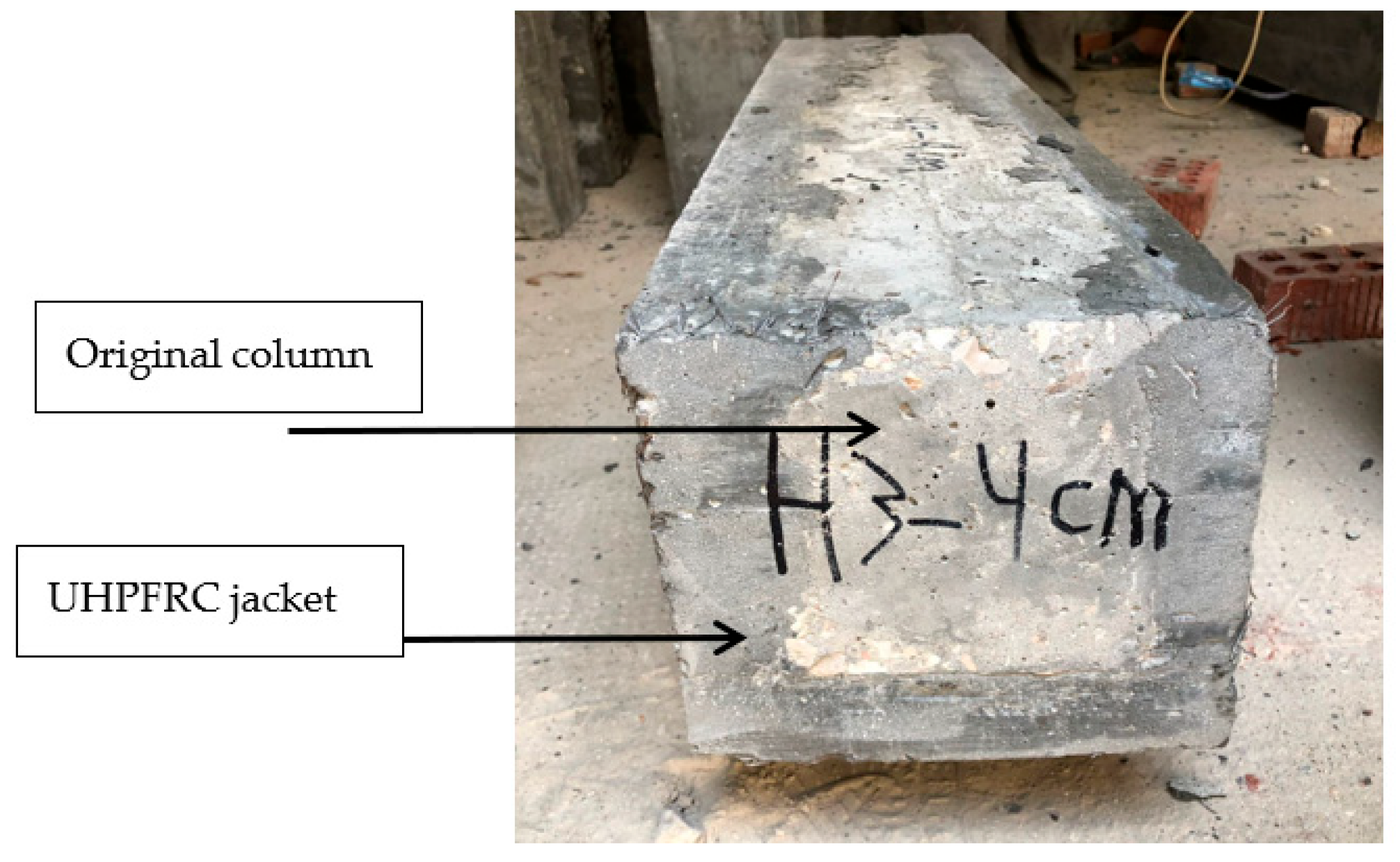

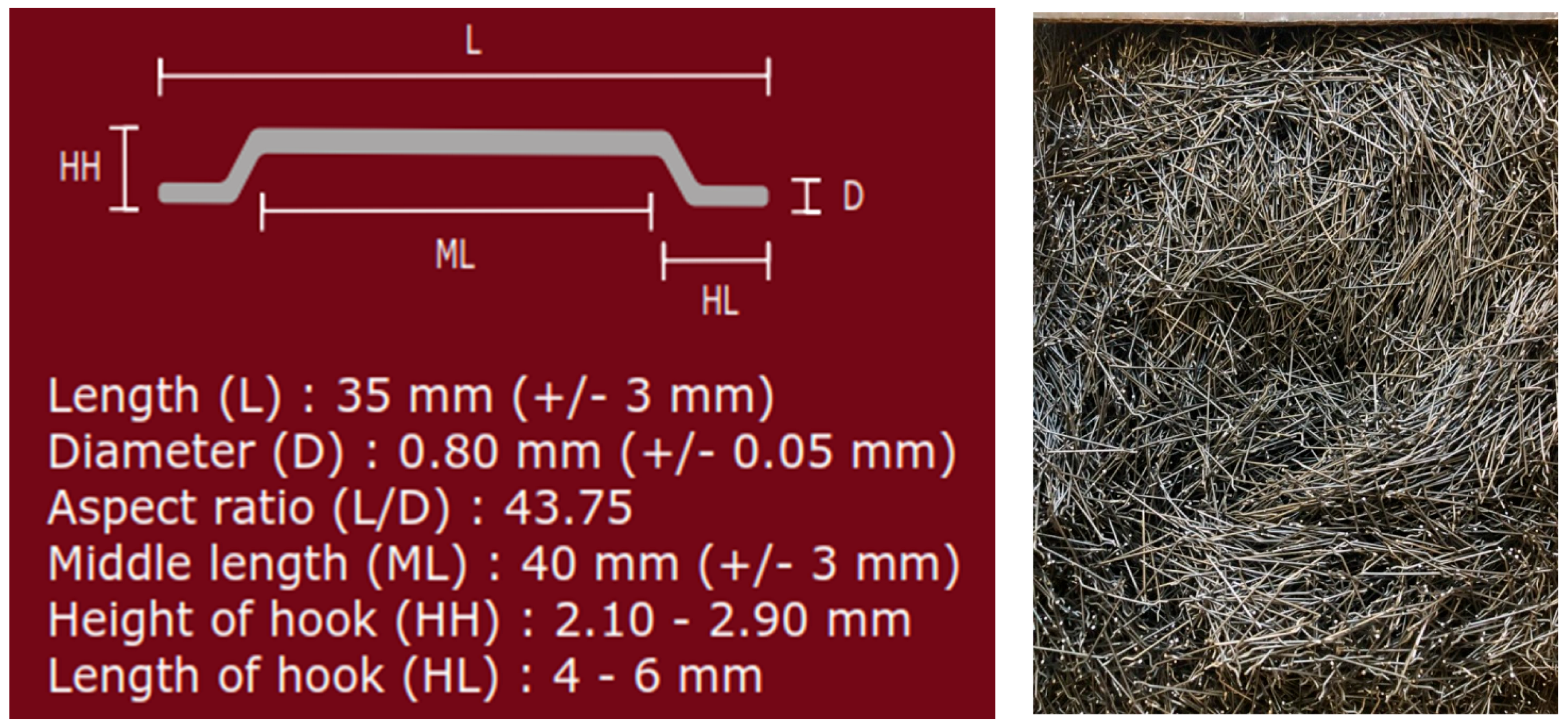

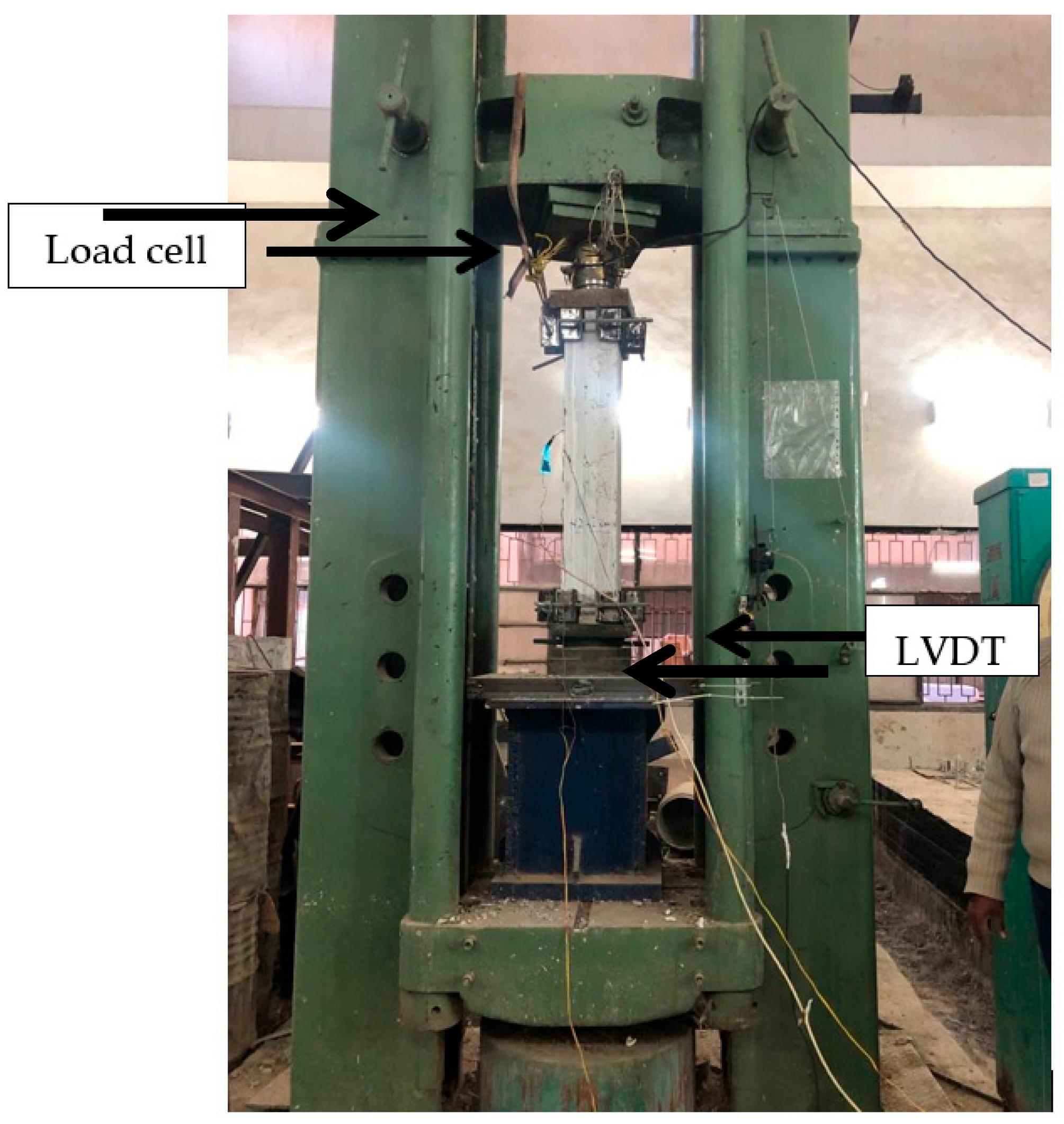
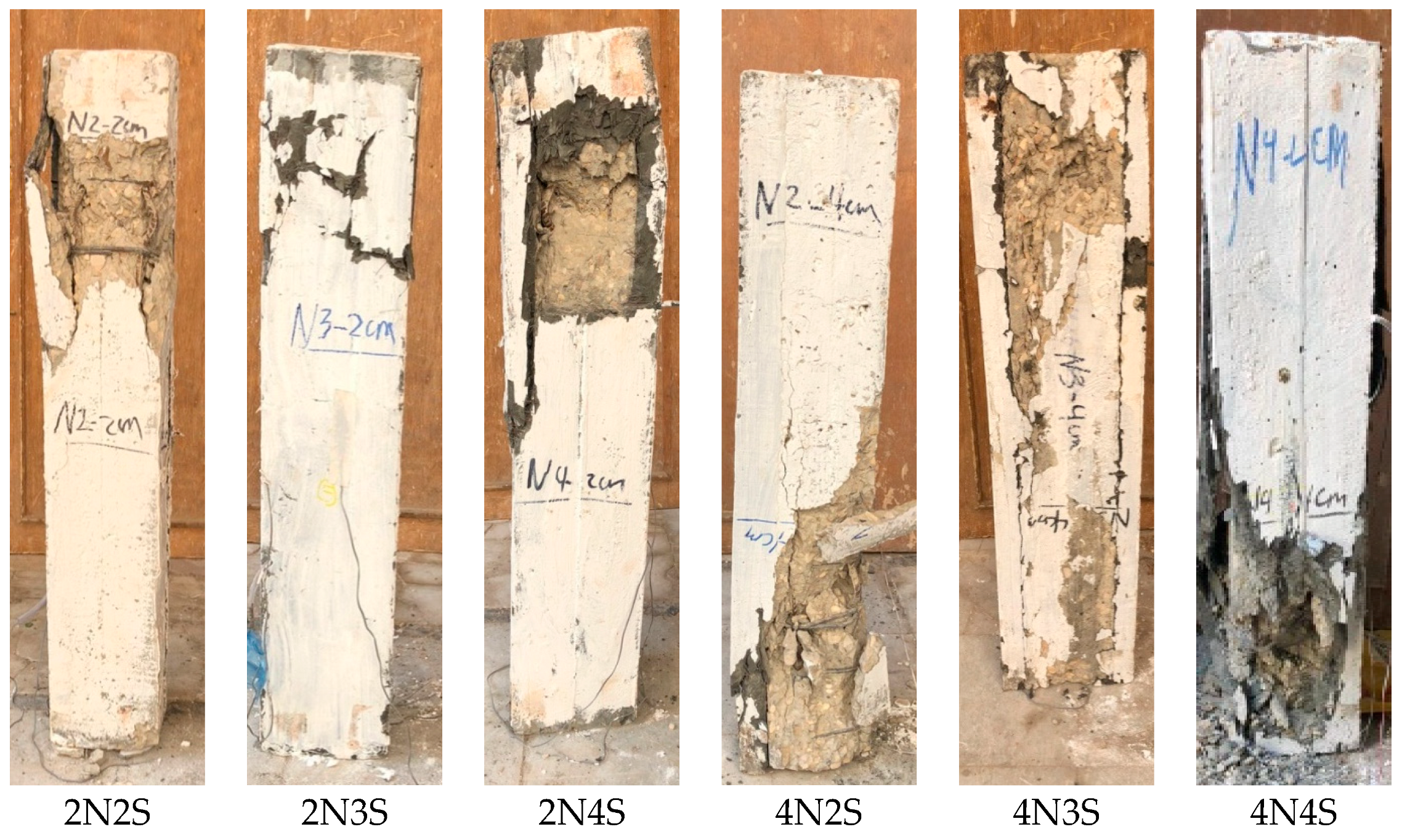
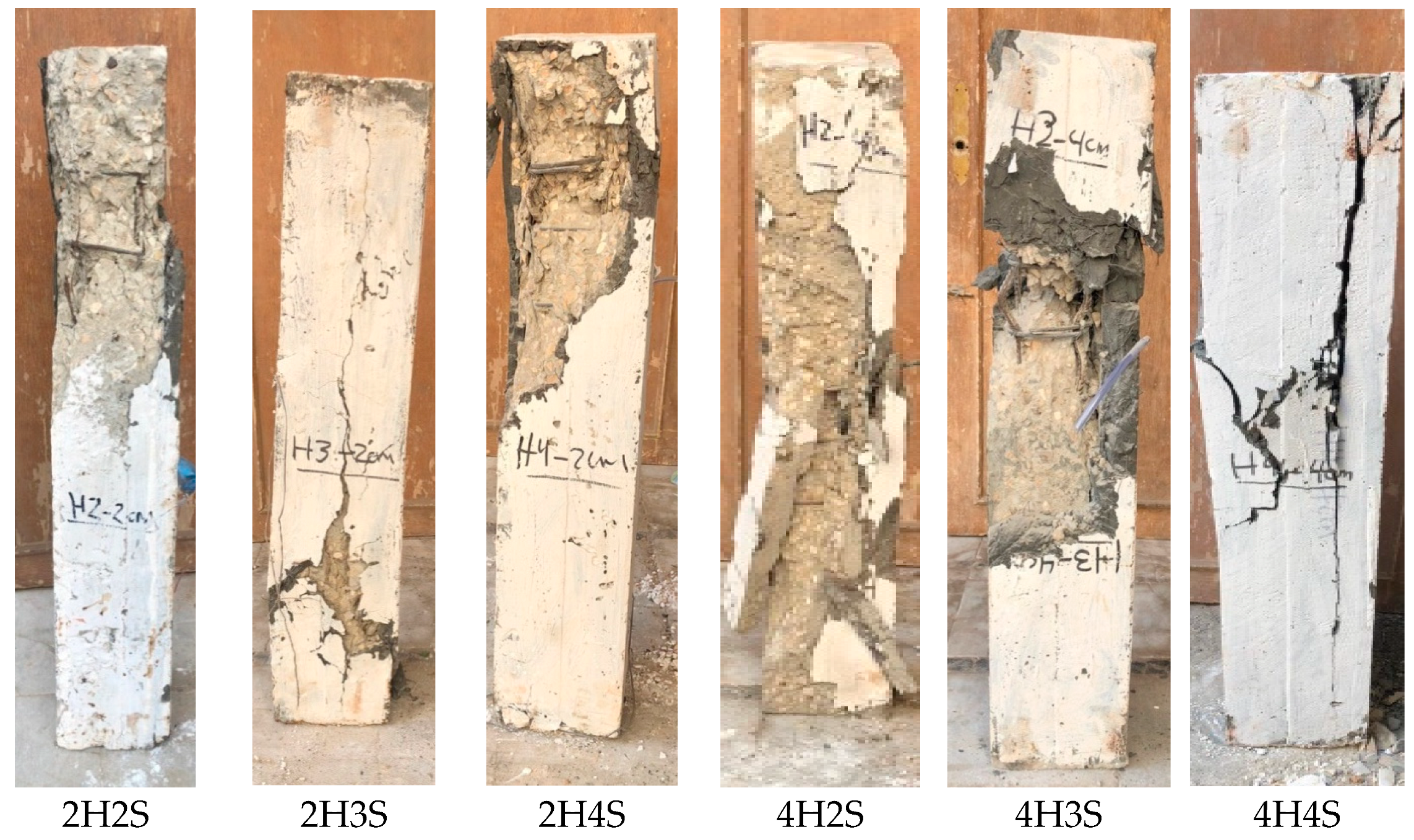

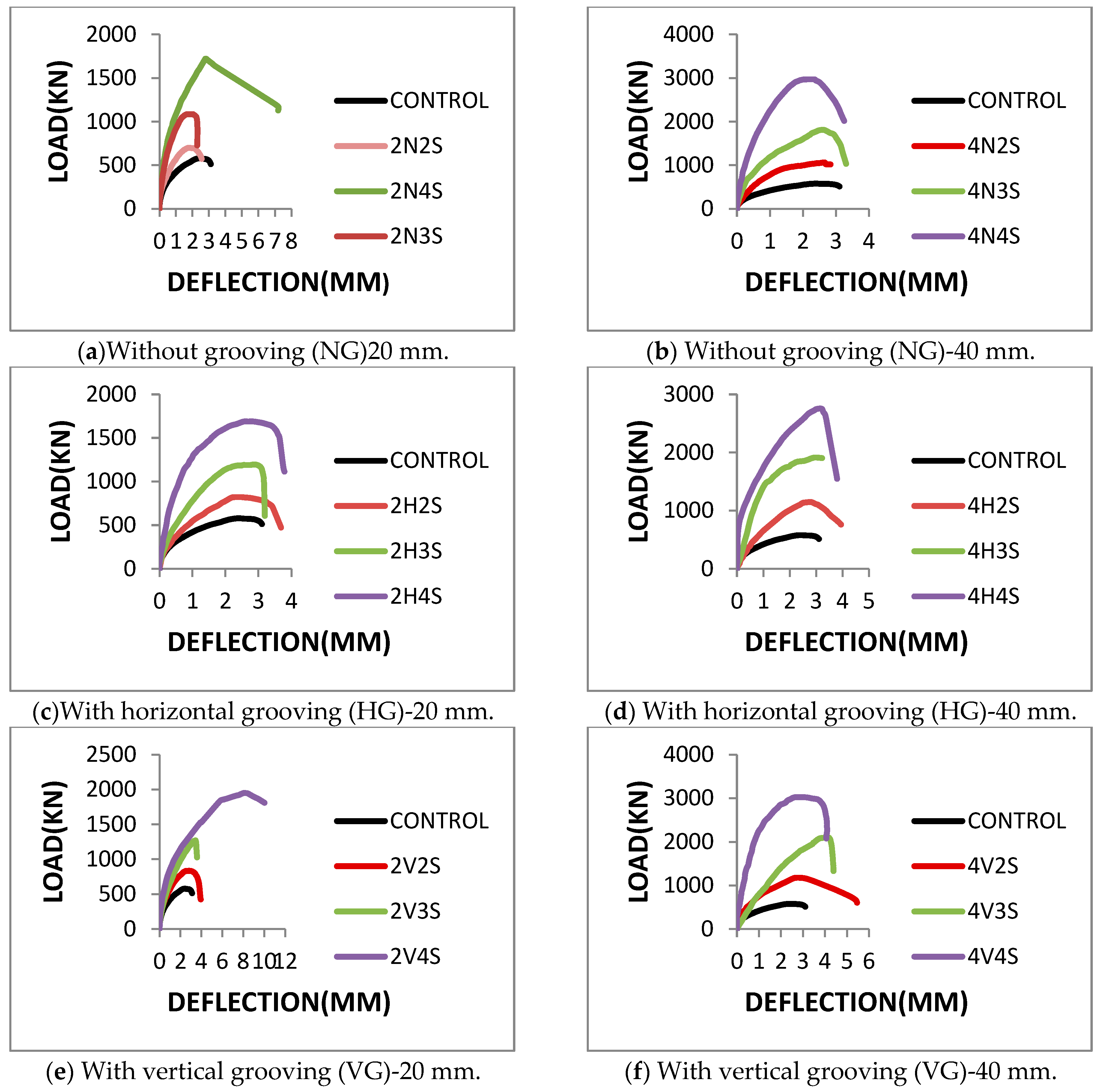
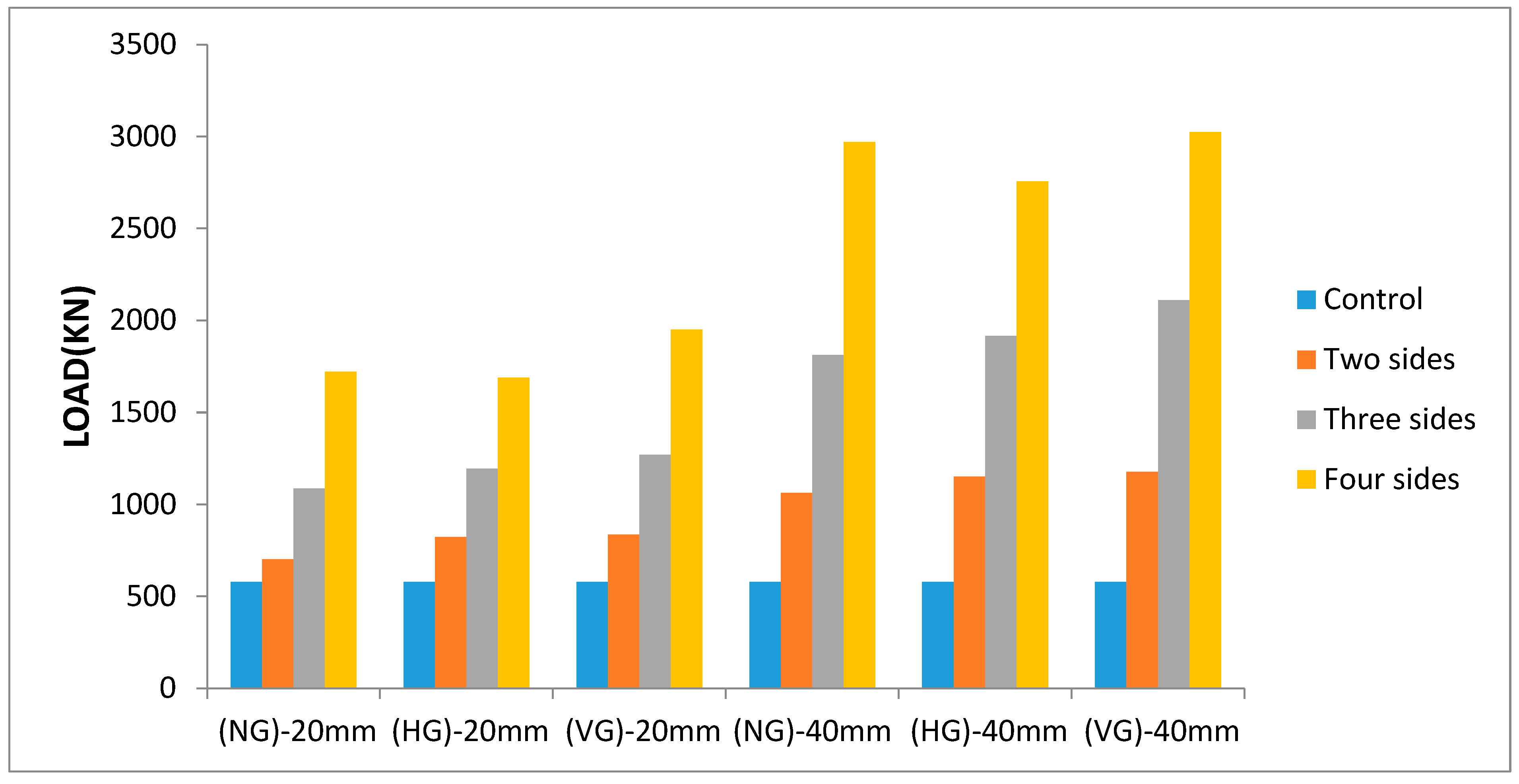
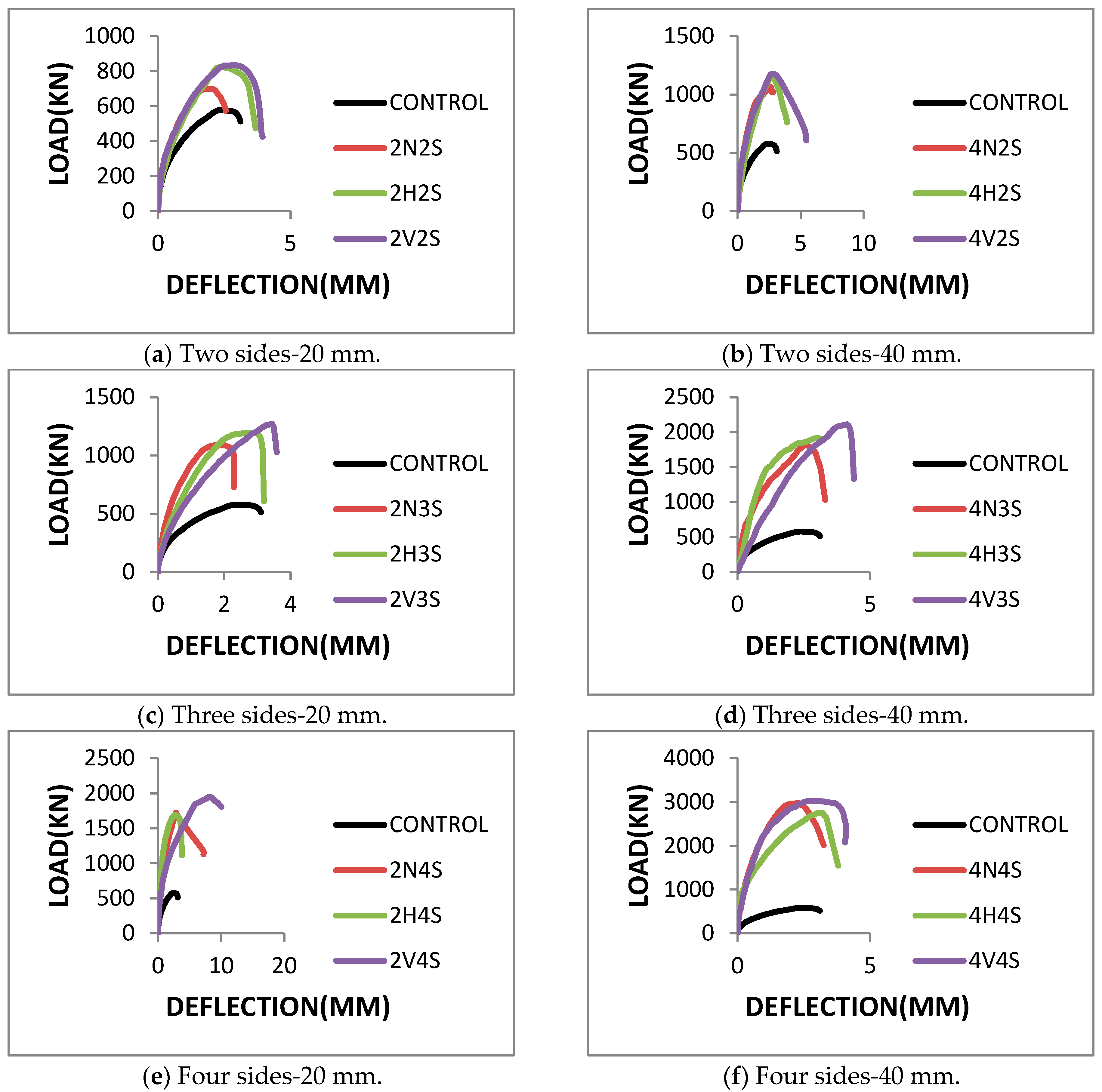
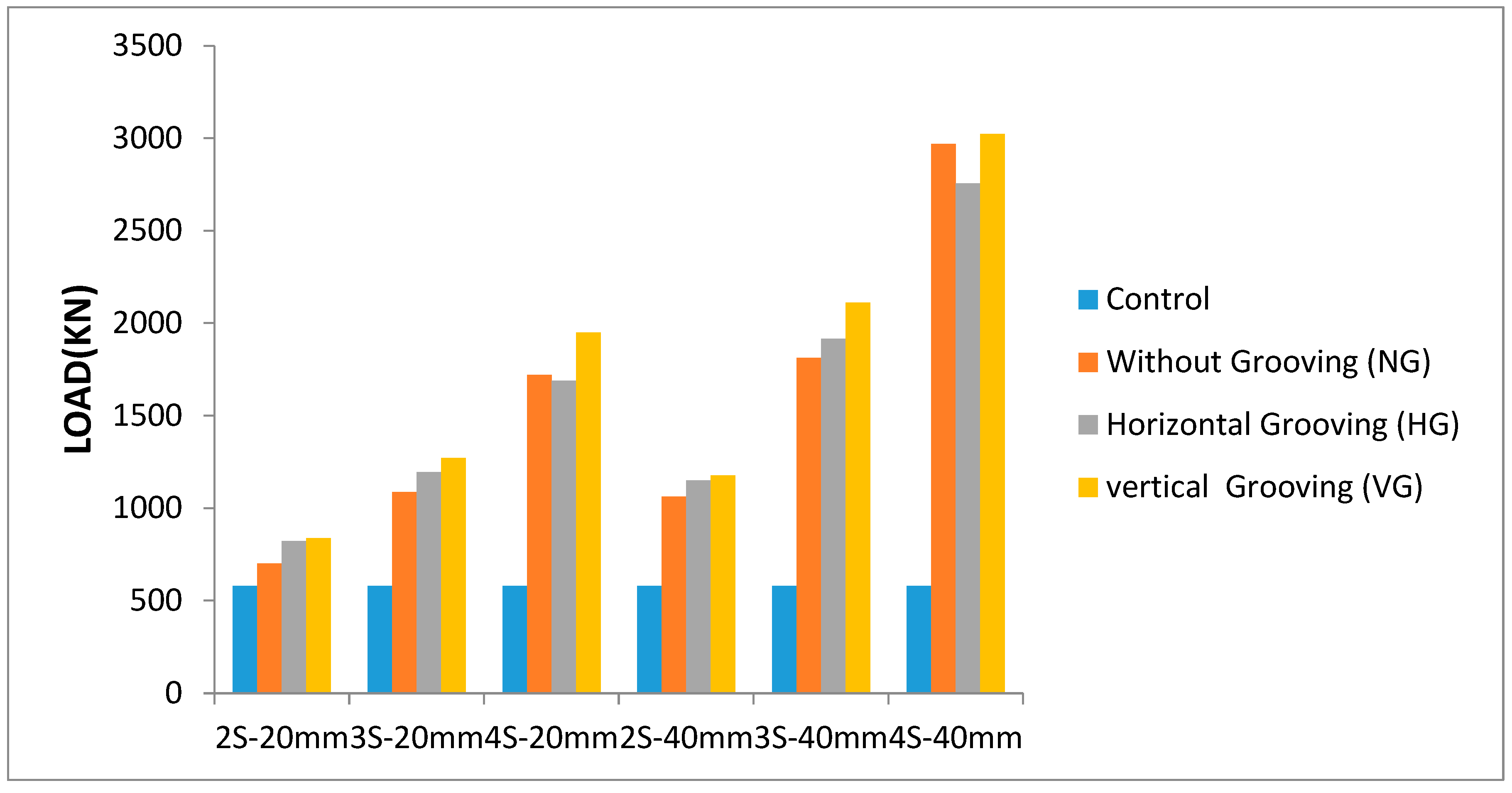
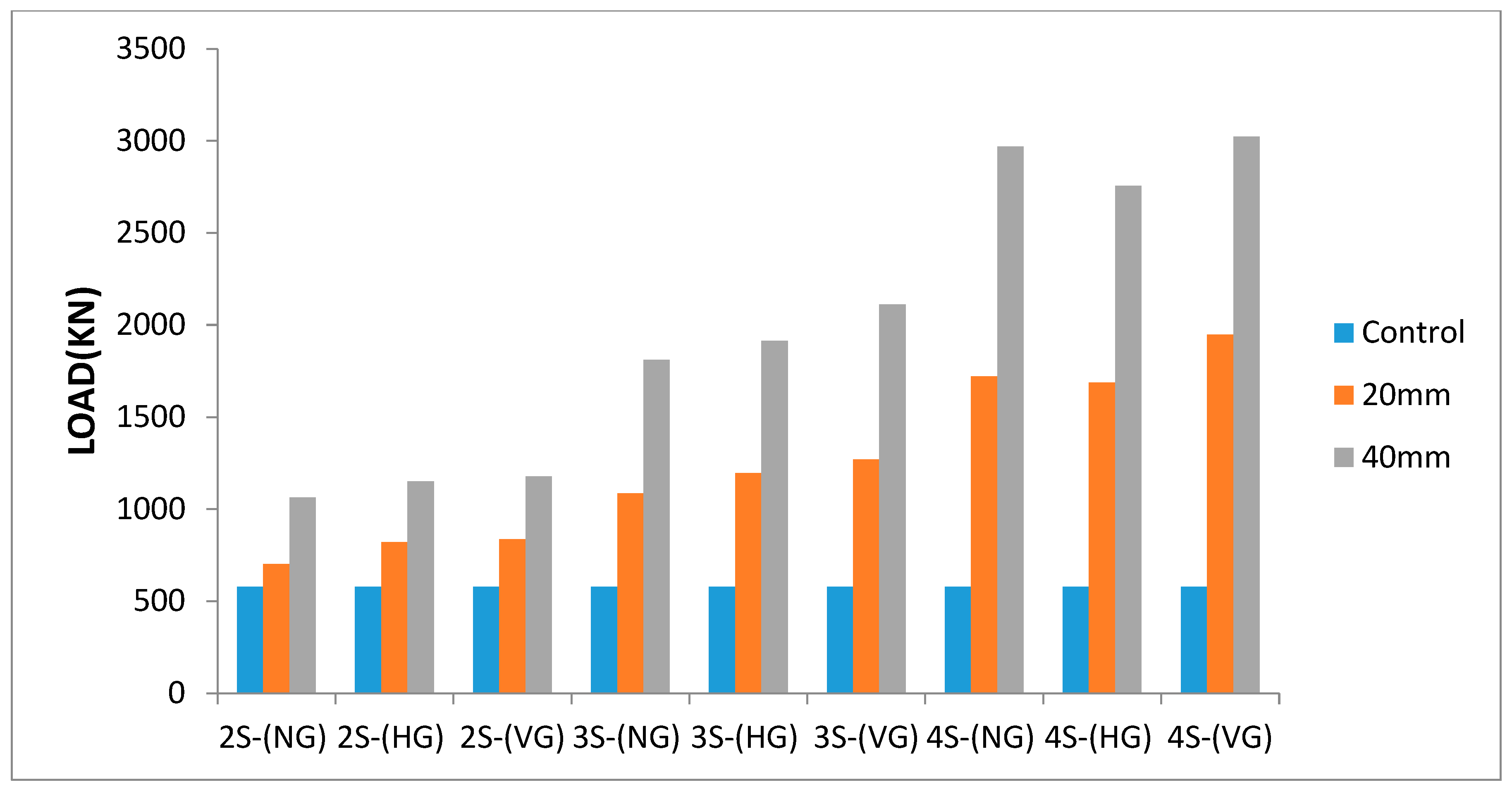
| Group | Specimen | Jacket Thickness | Number of Strengthened Sides | Interface Methods | Specimen Dimension |
|---|---|---|---|---|---|
| 1 | Control | ----- | ----- | ----- | 150 × 150 mm |
| 2 | 2N2S | 20 mm | 2 | without grooving | 170 × 170 mm |
| 2V2S | 20 mm | 2 | vertical grooving | 170 × 170 mm | |
| 2H2S | 20 mm | 2 | horizontal grooving | 170 × 170 mm | |
| 3 | 2N3S | 20 mm | 3 | without grooving | 190 × 170 mm |
| 2V3S | 20 mm | 3 | vertical grooving | 190 × 170 mm | |
| 2H3S | 20 mm | 3 | horizontal grooving | 190 × 170 mm | |
| 4 | 2N4S | 20 mm | 4 | without grooving | 190 × 190 mm |
| 2V4S | 20 mm | 4 | vertical grooving | 190 × 190 mm | |
| 2H4S | 20 mm | 4 | horizontal grooving | 190 × 190 mm | |
| 5 | 4N2S | 40 mm | 2 | without grooving | 190 × 190 mm |
| 4V2S | 40 mm | 2 | vertical grooving | 190 × 190 mm | |
| 4H2S | 40 mm | 2 | horizontal grooving | 190 × 190 mm | |
| 6 | 4N3S | 40 mm | 3 | without grooving | 230 × 190 mm |
| 4V3S | 40 mm | 3 | vertical grooving | 230 × 190 mm | |
| 4H3S | 40 mm | 3 | horizontal grooving | 230 × 190 mm | |
| 7 | 4N4S | 40 mm | 4 | without grooving | 230 × 230 mm |
| 4V4S | 40 mm | 4 | vertical grooving | 230 × 230 mm | |
| 4H4S | 40 mm | 4 | horizontal grooving | 230 × 230 mm |
| Coarse Aggregate (Size 1) | Coarse Aggregate (Size 2) | Fine Aggregate (Sand) | Cement | Water |
|---|---|---|---|---|
| 671 kg/m3 | 671 kg/m3 | 671 kg/m3 | 300 kg/m3 | 150 kg/m3 |
| Sieve opening (mm) | 20 | 14 | 10 | 4.76 |
| % Passing | 100 | 96.9 | 45.03 | 0.6 |
| Sieve opening (mm) | 20 | 14 | 10 | 4.76 |
| % Passing | 81.7 | 13.9 | 0.2 | 0.0 |
| Sieve opening (mm) | 5 | 2.36 | 1.18 | 0.60 | 0.30 | 0.15 |
| % Passing | 98 | 92.6 | 76.8 | 48.4 | 14 | 2.8 |
| Cement | Sand | Quartz Powder | Slice Fume | Water | Superplasticizer | Steel Fiber |
|---|---|---|---|---|---|---|
| 950 kg/m3 | 690 kg/m3 | 220 kg/m3 | 231 kg/m3 | 130 kg/m3 | 30 kg/m3 | 152 kg/m3 |
| Sieve opening (mm) | 0.60 | 0.30 | 0.15 | pan |
| % Passing | 93.4 | 32.4 | 5.4 | 0.0 |
| Property | Measured Values | Limitations |
|---|---|---|
| Physical properties | ||
| Color | Light gray | -- |
| Specific gravity | 2.15 | -- |
| Bulk density (kg/cm2) | 340 | 250–450 kg/m3 |
| Chemical properties | ||
| SiO2 | 97% | 90% min |
| C | 0.5% | 1% max |
| Fe2O3 | 0.5% | 1.5% max |
| Al2O3 | 0.2% | 1% max |
| CaO | 0.2% | 1% max |
| MgO | 0.5% | 1.5% max |
| K2O | 0.5% | 1.5% max |
| Na2O | 0.2% | 0.5% max |
| SO3 | 0.15% | 0.2% max |
| Cl | <0.01% | 0.05% max |
| H2O | 0.5% | 0.8% max |
| Property | Measured Values |
|---|---|
| Physical properties | |
| Color | White |
| Specific gravity | 2.60 |
| Grain Shape | angular |
| Moisture | 0.02% |
| Chemical properties | |
| SiO2 | 99.76 |
| TiO2 | 0.005 |
| Al2O3 | 0.01 |
| Fe2O3 | 0.039 |
| Mno2 | 0.006 |
| MgO | 0.002 |
| Cao | 0.012 |
| Na2O | 0.008 |
| K2O | 0.006 |
| P2O5 | 0.007 |
| Appearance | Specific Gravity | PH Value | Chloride Content |
|---|---|---|---|
| Brown colored liquid | 1.07 | 5.0–7.0 | “Chloride-free” to EN934-2 |
| Group | Specimen | Ultimate Load (KN) | Ultimate Deflection (mm) | Load Increase % | Concrete Ultimate Strain | Failure Mode |
|---|---|---|---|---|---|---|
| 1 | Control | 579.3 | 2.422 | ----- | ----- | brittle failure |
| 2 | 2N2S | 701 | 1.836 | 21% | without grooving | brittle failure |
| 2V2S | 836.5 | 2.818 | 44.4% | vertical grooving | brittle failure | |
| 2H2S | 822 | 2.488 | 41.9% | horizontal grooving | brittle failure | |
| 3 | 2N3S | 1086.1 | 2.026 | 87.5% | without grooving | brittle failure |
| 2V3S | 1270.9 | 3.443 | 119.4% | vertical grooving | brittle failure | |
| 2H3S | 1195.4 | 2.909 | 106.4% | horizontal grooving | brittle failure | |
| 4 | 2N4S | 1720.7 | 2.836 | 197% | without grooving | brittle failure |
| 2V4S | 1948.92 | 8.205 | 236.4% | vertical grooving | brittle failure | |
| 2H4S | 1688.7 | 2.851 | 191.5% | horizontal grooving | brittle failure | |
| 5 | 4N2S | 1063.05 | 2.656 | 83.5% | without grooving | brittle failure |
| 4V2S | 1177.26 | 2.674 | 103.2% | vertical grooving | brittle failure | |
| 4H2S | 1150.74 | 2.787 | 98.6% | horizontal grooving | brittle failure | |
| 6 | 4N3S | 1812.09 | 2.632 | 212.8% | without grooving | brittle failure |
| 4V3S | 2110.31 | 4.137 | 264.3% | vertical grooving | brittle failure | |
| 4H3S | 1914.28 | 2.981 | 230.4% | horizontal grooving | brittle failure | |
| 7 | 4N4S | 2968.98 | 2.353 | 412.5% | without grooving | brittle failure |
| 4V4S | 3022.96 | 3.080 | 421.8% | vertical grooving | brittle failure | |
| 4H4S | 2755.71 | 3.190 | 375.7% | horizontal grooving | brittle failure |
| N-20mm | H-20mm | V-20mm | N-40MM | H-40MM | V-40MM | ||
|---|---|---|---|---|---|---|---|
| two sides | Ultimate load (P)-(KN) | 701 | 822 | 836.5 | 1063.05 | 1150.74 | 1177.26 |
| Control column load (P0)-(KN) | 579.3 | 579.3 | 579.3 | 579.3 | 579.3 | 579.3 | |
| cross section jacket area (A0)-(mm) | 6400 | 6400 | 6400 | 13,600 | 13,600 | 13,600 | |
| jacket load(P1)-(KN) | 121.7 | 242.7 | 257.2 | 483.75 | 571.44 | 597.96 | |
| three sides | Ultimate load (P)-(KN) | 1086.1 | 1195.4 | 1270.9 | 1812.09 | 1914.28 | 2110.31 |
| Control column load (P0)-(KN) | 579.3 | 579.3 | 579.3 | 579.3 | 579.3 | 579.3 | |
| cross section jacket area (A1)-(mm) | 9800 | 9800 | 9800 | 21,200 | 21,200 | 21,200 | |
| A1/A0 | 1.54 | 1.54 | 1.54 | 1.56 | 1.56 | 1.56 | |
| jacket load(P2)-(KN) | 187.42 | 373.76 | 396.09 | 754.65 | 891.45 | 932.82 | |
| Confinement load(KN) | 319.38 | 242.34 | 295.51 | 478.14 | 443.53 | 598.19 | |
| four sides | Ultimate load (P)-(KN) | 1720.7 | 1688.7 | 1948.92 | 2968.98 | 2755.71 | 3022.96 |
| Control column load (P0)-(KN) | 579.3 | 579.3 | 579.3 | 579.3 | 579.3 | 579.3 | |
| cross section jacket area (A1)-(mm) | 13,600 | 13,600 | 13,600 | 30,400 | 30,400 | 30,400 | |
| A1/A0 | 2.13 | 2.13 | 2.13 | 2.24 | 2.24 | 2.24 | |
| jacket load(P2)-(KN) | 259.23 | 516.96 | 547.84 | 1083.6 | 1280.03 | 1339.44 | |
| Confinement load(KN) | 882.17 | 592.44 | 821.78 | 1306.08 | 896.38 | 1104.22 | |
| Confinement load = Ultimate load (P)—Control column load (P0)—Jacket load (P2) | |||||||
| jacket load(P2) = jacket load for two sided UHPFRC strengthened columns (P1) × A1/A0 | |||||||
Disclaimer/Publisher’s Note: The statements, opinions and data contained in all publications are solely those of the individual author(s) and contributor(s) and not of MDPI and/or the editor(s). MDPI and/or the editor(s) disclaim responsibility for any injury to people or property resulting from any ideas, methods, instructions or products referred to in the content. |
© 2023 by the authors. Licensee MDPI, Basel, Switzerland. This article is an open access article distributed under the terms and conditions of the Creative Commons Attribution (CC BY) license (https://creativecommons.org/licenses/by/4.0/).
Share and Cite
Shehab, H.; Eisa, A.; Wahba, A.M.; Sabol, P.; Katunský, D. Strengthening of Reinforced Concrete Columns Using Ultra-High Performance Fiber-Reinforced Concrete Jacket. Buildings 2023, 13, 2036. https://doi.org/10.3390/buildings13082036
Shehab H, Eisa A, Wahba AM, Sabol P, Katunský D. Strengthening of Reinforced Concrete Columns Using Ultra-High Performance Fiber-Reinforced Concrete Jacket. Buildings. 2023; 13(8):2036. https://doi.org/10.3390/buildings13082036
Chicago/Turabian StyleShehab, Hamdy, Ahmed Eisa, Ahmed Mohamed Wahba, Peter Sabol, and Dušan Katunský. 2023. "Strengthening of Reinforced Concrete Columns Using Ultra-High Performance Fiber-Reinforced Concrete Jacket" Buildings 13, no. 8: 2036. https://doi.org/10.3390/buildings13082036
APA StyleShehab, H., Eisa, A., Wahba, A. M., Sabol, P., & Katunský, D. (2023). Strengthening of Reinforced Concrete Columns Using Ultra-High Performance Fiber-Reinforced Concrete Jacket. Buildings, 13(8), 2036. https://doi.org/10.3390/buildings13082036







